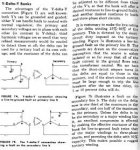PVfarmer
Senior Member
- Location
- Newport County, Rhode Island, USA
1. Nothing wrong with this, except that you end up with three _separate_ 120/240 systems. Each system has a different phase angle, meaning different timing of the zero crossings of the AC cycle. You would have a heck of a time supplying your current 120/240 loads, unless you could easily divide them up into subsets.
2. This sort of 'triple 120/240' system is also called 'hexaphase', and is sometimes used to reduce harmonic issues from computer systems and the like
3. Every transformer derives its output from the changing magnetic field in the core. If the transformer has a neutral, then this is a 'derived' neutral.
4. A 'high leg delta' has a center tap in one leg of the secondary (as you describe). This secondary becomes the 'base' of your 120/240V system. The benefit here is that the 'side legs' provide some of the power for your 120/240V system, so your single phase 120/240V consumption gets somewhat distributed over all three phases.
-Jon
1. SO...subsets...meaning...run all of the 240V/heavier/motor loads off of one of those three and use the other 2 for 120V?
Or...use two for the 240V and one for the 120V loads?
The second one makes sense offhand- there's one big 240V load that's a bunch of 240V motors, other 240V loads are more "spaced out", welder here, compressor there, and then the 120V is the smallest (amp wise) of the group.
2. Neat! However, it's a barn, not a data center or hospital, so would "hexaphase" be...over-engineering it?
3. Got it. So if one side of the xfmr has a neutral and the other doesn't...there's no transfer?
4. OK. So then the high leg IS contributing, and not just "unused"?
Thanks!


